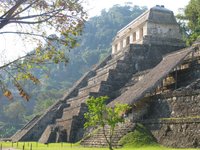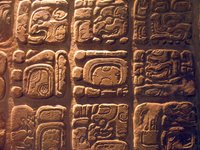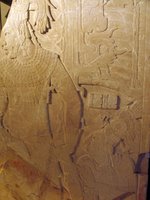Mexico
Last week we traveled to Chiapas, Mexico, home of the Zapatistas. Our trip started off by crossing the border standing in the back of a pick-up truck, illegally. Nine forms of transportation, one night over in Comitán, and one nervous run-in with Mexican military later, we finally arrived in the artsy and super-relaxing city of San Cristóbal de las Casas.
The highlight was Taller Leñateros, a cooperative art workshop (of the indigenous Tzotzil Maya) that produces elegant hand-made paper, provocative silk-screens and woodcuts, and hand-sewn books. They are most well known for their magazine, La Jícara, which always has unique and extremely creative editions filled with original art pieces, poetry, and politics. It was a dream, and one that I am beginning to envision in my own future. The pictures show a Tzotzil woman plucking dried flower petals for the paper and an example of their artwork.


We also took a couple days and traveled to the ancient city of Palenque, one of the top Mayan sites. The Maya civilization reached its period of greatest development about A.D. 250 and continued to flourish for hundreds of years. They produced exceptional architecture and sculpture, made great advancements in astronomy and mathematics and developed an accurate yearly calendar. And, they were one of the first peoples in the Western Hemisphere to develop an advanced form of writing. Today descendents of the Mayas live all over Mexico and Central America, speaking more than 20 different languages and dialects that developed from the ancient Mayan language.



Palenque sits in the Lancandona jungle of Chiapas. It had 19 governors over the course of 700 years, from 100 A.D. to 804 A.D., and housed approximately 8,000 people near its end. It is thought that the lack of resources in food, water, and housing in this over-populated city forced the Mayas to abandon it. This being my first experience with the Mayas, I was most impressed with the designs of their writing system and the intricate relief sculptures. It was ancient candy for my artistic eyes.
Similar to my visit to the Incan ruins of Peru, I felt an other-worldliness here. The temples and palaces are so high up, entirely vulnerable to the sky, and placed in relation to one another that calls attention to the negative space of the air between the structures and to all the air above us, that we cannot grasp, but we can only hope will swoop low enough for us to experience. Modern buildings are tall, but closed off, with compartments and small spaces that confine and constrain. These temples confidently and fully expose themselves to the sky, like they’re not afraid of the gods, as if they have some secret insight.

1 Comments:
Victoria Tai is living in Chiapas, working with the indigenous Mayan at Taller Lenateros and blogging about her experience. Check out here blog at:
http://lenateros.wordpress.com/
Post a Comment
<< Home